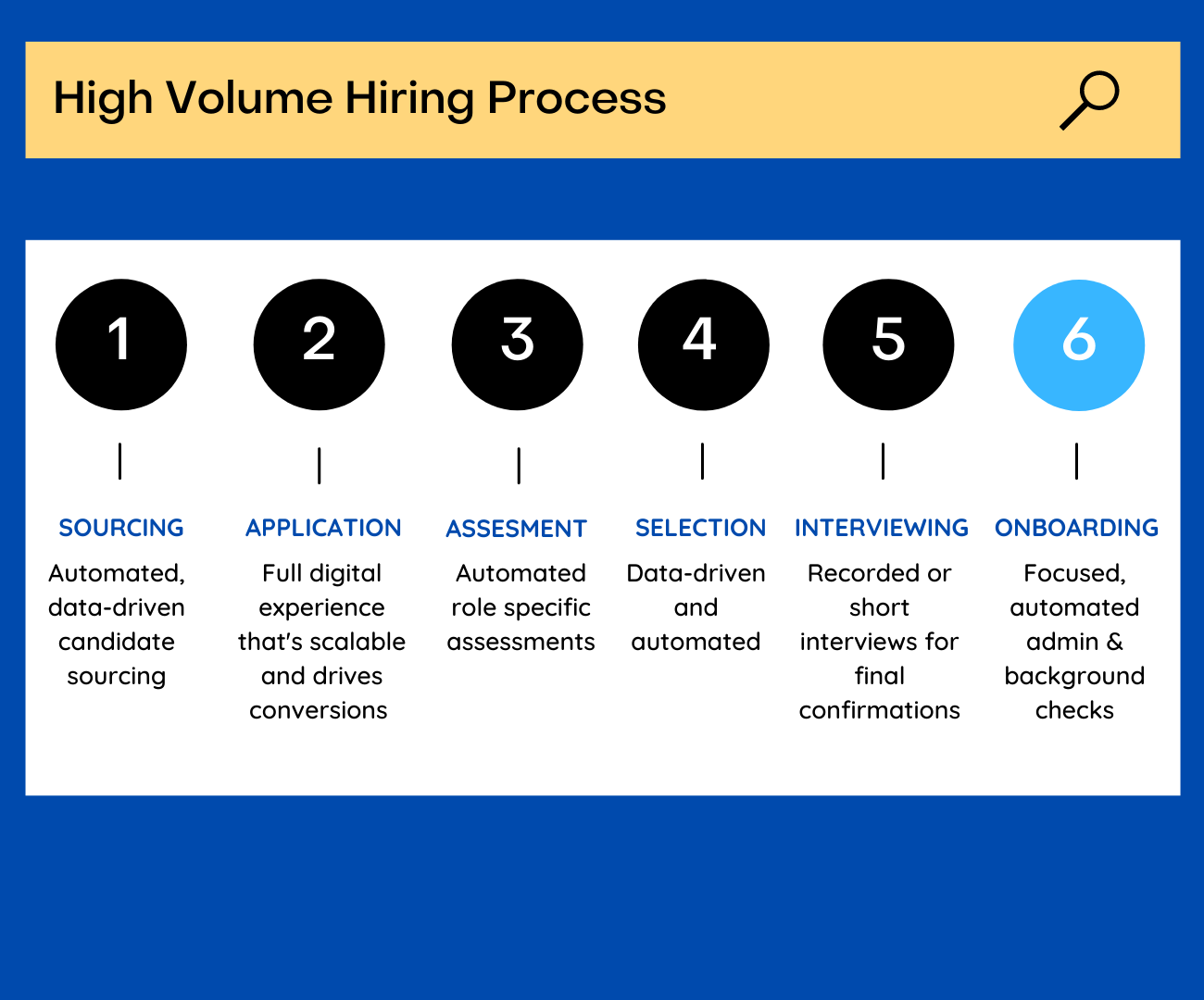If you’re planning to delve into the world of high-volume hiring, you’ll need a plan- an essential guide for surviving high-volume hiring, if you will.
Typically, businesses turn to high-volume recruiting in times of extreme growth, during seasonal peaks, or when opening a new office. You’ll need to employ tangible high-volume recruitment strategies to get the best talent within the required time.
What is high-volume hiring?
High-volume hiring doesn’t constitute an exact number but rather a process that involves hiring high numbers of staff in a specific time period. It also comes into play for single job roles with considerable numbers of candidates (we’re talking in the hundreds).
As this process involves large numbers of candidates, a high-volume recruiter must be able to use all the tools and knowledge at their disposal to decide which applicants are suitable to progress to the interview stage. For example, they may choose to use AI-powered recruiting tools.
Finding and evaluating a high volume of candidates for different job roles, all of whom need to be identified, interviewed, assessed, and onboarded, also comes with placement targets to meet. If this all sounds stressful, it’s because it is.
That’s why it’s essential to establish well-defined processes and use the right tools for the job, such as team task management software, to help identify what resources you’ll need and prioritize tasks.
In this guide, you’ll learn how to navigate high-volume hiring with success (and minimal stress). Let Operation High-Volume Hiring commence!

What are the challenges of high-volume hiring?
Of course, recruiting high numbers of people at the same time doesn’t come without its challenges. These range from time constraints to advertising in the best places to attract the most suitable candidates. Let’s explore the key challenges and how you can overcome them.
What’s the job role again?
Filling many positions at the same time is not conducive to knowing exactly what each job role demands. Misaligned job role expectations and a lack of role transparency can also cause issues in a high-volume hiring environment. As talent acquisition is often a result of major business growth, understanding how workloads will function in reality can be a challenge.
How to overcome this challenge:
Critical skills and competencies are top of the agenda to streamline your high-volume hiring process. To develop an efficient hiring process, be exact in candidate expectations to focus your attention on suitable candidates. Recruiters should also communicate and work collaboratively with hiring managers by scheduling intake meetings and discussing expectations for the role early.
Unnecessary applications stress
The method of applications makes a huge difference in how efficient your hiring process is. If your system spontaneously combusts at the concept of processing high volumes of applicants, you won’t be able to scale effectively. To avoid this, look for a job application platform that is able to handle large volumes of applicants. Technology is your friend when it comes to removing the stress of a high-volume recruitment process.
You could also save time and reduce the number of applicants you need to manually review by using tests that each applicant must pass in order to progress to the next step of the recruitment process.
Also, consider where your candidates come from. When high-volume hiring, you need to be able to track more candidates than usual. The challenge is even more complex when hiring across the globe, which is more prevalent now that many roles offer the option of remote working. This can throw a spanner in the works when it comes to things like arranging an interview time that suits everyone involved.
How to overcome this challenge:
Optimize your application process by following processes to facilitate all possible platforms, such as employment sites, country-specific domains, and social media. Ensure your application platform is compatible with smartphones.
Difficulty matching candidates to job roles
With such a large number of applications to sort through, it can be difficult to decide which applicant is most suited for which role. Maybe you have applicants whose skills and experience make them suitable for several of the roles that you’re hiring for, and it can be difficult trying to decide which role they would suit best.
This can lead to you spending hours - or days - compiling lists of pros and cons for each candidate within each role. Of course, this is valuable time that could be used for other important tasks.
How to overcome this challenge:
Use fit-for-purpose candidate matching technology for high-volume recruiting. You want software that facilitates selection automation and shortlisting of suitable applicants quickly.

Explore intuitive candidate matching technology that both sells and assesses job roles to applicants. This gives candidates an understanding of the job role to ascertain if they want to apply. Matching software drives objective, data-driven hiring decisions.
When looking for the right high-volume hiring software, ensure your business needs are met, and look at features like:
- Pre and post-application support
- Applicant information storage
- Automation capabilities
- Social media integration
- Applicant self-screening functionalities
- User-friendly dashboard
High-volume hiring technology enables a higher quality of hire without increasing the cost to hire. Hire better quality candidates and reduce long-term attrition.
Pro Tip: connect hiring software to your business phone system to avoid missed candidate calls in this frenetic hiring process.
How to manage high volume hiring
To survive your first experience at high-volume hiring, follow these principles:
- Optimize content
- Use candidate matching technology
- Implement automation and AI
- Evaluate applicant experience
Let’s take a closer look at how best to introduce these principles.

Optimize content
When advertising high-volume hiring jobs, develop your content strategically to engage as many skilled applicants as possible within your time frame.
Use all the platforms at your disposal to create:
- Catchy job ads: describe the company values in the ad so candidates get a feel for the company before they apply. Include relevant company perks and positive things about the business. Work on a branding presence to make your business an appealing prospect for candidates.
- Clear job descriptions: explain what a vacancy will entail so that each applicant knows exactly what will be expected of them if their application is successful. Each job description should explain whether the role is temporary or permanent, whether the role is full-time or part-time, where the job will be based, what qualifications and experience are required, and what tasks the successful applicant will be expected to perform.
- Screening questions, if required: as a preliminary screening as part of the recruitment process, ask applicants questions to help you determine whether they’re suitable to progress further in the recruitment process.
- Mobile-first applications: make your job application easy to fill in on a mobile device to avoid deterring any applicants who prefer to use their mobile to apply for jobs. Many job seekers use their mobile to search for jobs but find it easier to turn to their computer to complete their application.
Optimize your website to handle increased traffic during the high-volume hiring process. This includes a mobile-friendly site, inclusive language, and site architecture built for large and sudden volumes of traffic. Make sure your SEO is on point to ensure as many potential candidates see your ads as possible.
Platforms for job role postings should include social media channels, job boards, your website’s career page, and any online niche groups with active potential candidates. Businesses that often hire in volume use programmatic job advertising.
This works by employing a team that deploys software to purchase, publish, and optimize job postings. It can save time and increase your reach when handling high-volume hiring.
Automation and AI
With 55% of US human resources leaders using predictive algorithms to support their hiring process, the role of artificial intelligence in recruitment is here to stay. Many tasks associated with hiring are repetitive, and as such can be automated to save you time and money.
In fact, AI can automate your entire sourcing and matching hiring process. Automation streamlines your workflows, decreases hiring costs, and moves suitable candidates along your hiring funnel according to your set criteria.
The only parts of the hiring process requiring human handling are the interviews and making job role decisions. For this, consider video interviewing to speed up this element of the hiring process.
Suddenly high-volume hiring isn’t looking too bad!
Here are a few ways you can use AI when high-volume hiring:
- Chatbots for applicant sourcing and scheduling interviews.
- Pattern matching technology for resume screening, ATS mining, and video interview capabilities.
- Communicating with potential candidates and sending automated replies.
Candidate experience
Even at the high-volume end of hiring, the application process has to be engaging and friendly to appeal to candidates. Making your hiring process as streamlined as possible doesn’t have to mean missing the human element. Applicant expectations are growing with an expectation of user-friendly experiences in all aspects of life. Applying for jobs is no exception.
To provide a great applicant experience, you should detail time frames and the hiring structure to ensure that applicants remain engaged with your business. Use your recruiting software to implement automated emails with important hiring process milestone dates.
Remember: Applicants are much more likely to accept job roles after positive application experiences.

High-volume hiring key metrics
Measuring the success of your mass recruitment drive is essential to forecast future goals.
Look at KPIs including:
- Time to hire: from posting job roles to filling positions, this metric helps manage and prioritize roles. Measuring your time to hire metric shows how effective your hiring strategy is.
- Cost to hire: it’s essential to constantly strive to reduce the cost to hire metrics. Cost to hire is a metric that can be dramatically reduced using the right technology and hiring tools. High-volume hiring affects the cost per hire, as staff shortages can delay planned expansions and vital business decisions.
- Source channel cost: monitor your ad spend on different channels to ascertain which are most effective. You’ll get instant feedback to immediately reduce costs if channels prove too expensive or ineffective.
- Offer acceptance rate: compare how many job roles are offered to how many acceptances you receive. This helps clarify your hiring process and the applicant experience. Explore which job roles have higher or lower acceptance rates, and ask for applicants to feedback on their views. Data gathering helps you attract, engage and retain higher-quality candidates.
Thriving through high-volume hiring
High-volume hiring is an integral element of many businesses' recruitment tactics. With the right process, hiring huge volumes of candidates is a challenging but not impossible task.
The best technology assessment platform coupled with hiring expertise will ensure that your high-volume recruitment strategy serves you well in the ever-changing recruitment environment.







